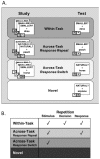Automaticity and Flexibility of S-R Retrieval During Priming
- PMID: 28608801
- PMCID: PMC5483638
- DOI: 10.3390/brainsci7060065
Automaticity and Flexibility of S-R Retrieval During Priming
Abstract
Learned associations between stimuli and responses (S-R associations) make important contributions to behavioral and neural priming. The current study investigated the automaticity and flexibility of these S-R associations and whether the global task context in which they occur modulates the impact of S-R retrieval on priming. Participants engaged in a semantic repetition priming task in which S-R retrieval is known to influence priming. Across participants, repetition priming occurred in global task contexts (i.e., combination of activated task sets) that either remained consistent or shifted across time. In the stable context group, the global task context at study matched that at test, whereas in the shifting context group, the global task context at study differed from that at test. Results revealed that the stability of the global task context did not affect the magnitude of S-R contributions to priming and that S-R contributions to priming were significant in both the stable and shifting context groups. These results highlight the robustness of S-R contributions to priming and indicate that S-R associations can flexibly transfer across changes in higher-level task states.
Keywords: associative learning; context; memory; repetition priming.
Conflict of interest statement
The authors declare no conflict of interest.
Figures



References
LinkOut - more resources
Full Text Sources
Other Literature Sources
Research Materials

